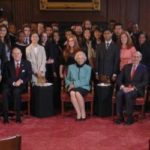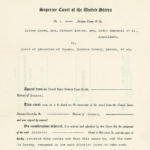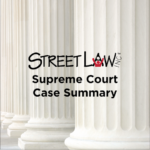In this lesson, students will read about a Kansas child involved in a famous United States Supreme Court case. They will think critically to form opinions about equality, segregation, and integration, and will distinguish between fact and opinion.
A Conversation on Brown v. Board of Education

Supreme Court Justices Stephen G. Breyer, Sandra Day O’Connor and Anthony M. Kennedy discuss with high school students this landmark case that ended racial segregation in schools. They explore the background of the case, the role of Thurgood Marshall, how Brown v. Board of Education was decided, and the events following the unanimous ruling that said that “separate education facilities are inherently unequal.” A PDF lesson plan accompanies this video.
Different Perspectives on the Civil Rights Movement
Anthony Badger uses the career of President Jimmy Carter to frame the questions of change in the American South and the relative impact that economic modernization, nonviolent protest, and armed self-defense had on the end of segregation and the steps taken toward political and social equality. Free registration for students and teachers required to access resource.
Patriotism Crosses the Color Line: African Americans in World War II
Professor Clarence Taylor reminds us of the role African American soldiers played in the conflict—and the role their military service played in shaping the racial politics that followed in peacetime. This essay helps us appreciate the complexity of mobilization for modern warfare and drive home the impact of events on the world stage upon domestic affairs. Free registration for students and teachers required to access resource.
Jim Crow Wisdom: Memory and Identity in Black America Since 1940
James Basker & Johnathan Holloway discuss the novel written by Mr. Holloway, Jim Crow Wisdom: Memory & Identity in Black America Since 1940.
Parents Involved v. Seattle (2007)
Brown v. Board of Education Lesson Collection

On May 17, 1954 the Brown v. Board of Education decision was made. This landmark Supreme Court decision declared that laws establishing separate public schools for black and white children were unconstitutional. The Brown v. Board of Education ruling overturned the Plessy v. Ferguson decision of 1896, which allowed state-sponsored segregation in public schools. To support teachers as they commemorate this important anniversary in their classes, the Share My Lesson team has selected a variety of free lesson plans, educational resources and classroom materials about equity, particularly in schools.
Different Treatment for Different Folks
The lesson begins with an illustration of the “separate but equal” doctrine – two water fountains are depicted, one labeled “colored” and the other labeled “white”. Students will discuss how this doctrine was used to justify separate treatment based on race, and that such a policy would not be legal today.
